The Place des Vosges, the oldest square in Paris, is one of the most beautiful squares in the world.
The Place des Vosges covers an area that forms an almost exact square, with each side measuring 140 meters (460 feet) in length. It consists of a fenced-off park surrounded by a low-trafficked street. The square is surrounded by arcades with shops and cafés.
History
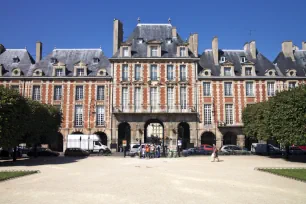
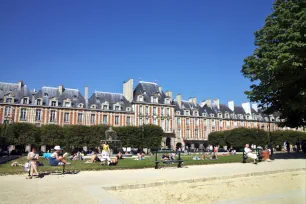
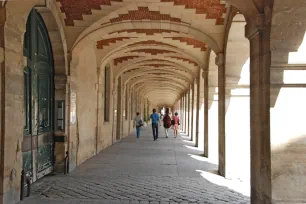
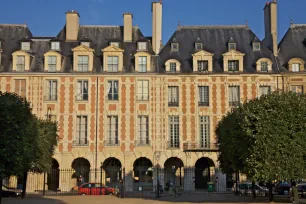
A symmetrical design
The history of the Place des Vosges goes back to 1604 when King Henry IV built a Royal pavilion at the southern end of the square. The building was designed by Baptiste du Cerceau, the architect who was also responsible for the design of the Pont Neuf.
The king ordered all 35 other buildings bordering the square to follow the same design. The result, an early example of urban planning, is a symmetrical square surrounded by buildings with red brick and white stone facades, steep slate roofs and dorm windows, all constructed over arcades.
The Royal pavilion at the center of the southern side, the so-called King’s Pavilion, was built on top of a gateway. At the northern side, mirroring the King’s Pavilion, is the Queen’s Pavilion.
The royal square
The square was officially inaugurated in 1612 as ‘Place Royale’ (Royal Square). At that time merely a lawn, it was a favorite place for duels.
Hôtel de Tournelles
Before the seventeenth century, a prominent building occupied the northern end of the square: the ‘Hôtel de Tournelles’. This grand building was constructed in 1388 and served as a residence for the royal family until 1559, when King Henry II was severely wounded during a tournament held at the site. He died ten days later in the Hôtel de Tournelles. His wife, Catherine de Medicis, had the building demolished and moved to the Louvre.
The Taxpaying Department
In 1800 Napoleon changed the name of the square from ‘Place Royale’ to ‘Place des Vosges’ to show his gratitude towards the Vosges department, the first department in France to pay taxes. It was again renamed Place Royale in 1815, only to be changed yet again into ‘Place des Vosges’ in 1870.
Sights
The park
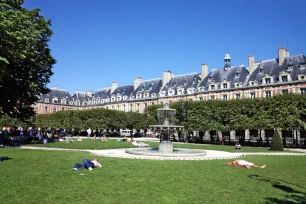
The Place des Vosges is now a peaceful place, with a park at its center. Just like the buildings that line the square, the park itself is symmetrically arranged around the statue of Louis XIII, which is enveloped by trees. Around the statue are four symmetrical lawns, each with their own fountain. There are also two sandboxes for small children to play in.
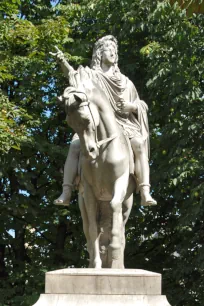
Statue of King Louis XIII
In 1639 Richelieu had a bronze equestrian statue erected at the center of the square. For the horse, a statue was taken that was originally created in 1567. It was supposed to hold a statue of King Henry II, but that was never completed, so an ill-fitting statue of King Louis XIII was placed on the horse instead.
This original statue was destroyed during the French Revolution. The one we see today is a statue of King Louis XII that was installed here in 1825. It was made four years earlier by Jean-Pierre Cortot after a model created by Charles Dupaty.
The statue shows the king dressed as a Roman emperor, crowned with a laurel wreath. It is set on a tall pedestal surrounded by a wrought-iron fence.
The house of Victor Hugo
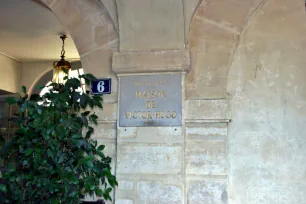
Many famous Frenchmen lived here at this square, among them several statesmen, the most famous of which was Richelieu. The square has also inspired many well-known authors such as Victor Hugo, Alphonse Daudet and Georges Simenon.
Cardinal Richelieu, who became prime minister of France in 1624 lived at no. 21 from 1615 to 1627.
Victor Hugo, author of ‘The Hunchback of Notre Dame’ lived on the second floor of house no. 6, the ‘Hôtel de Rohan-Guéménée’, from 1832 to 1848. The house, now called ‘Maison de Victor Hugo’ has been turned into a museum. You can visit the rooms where Victor Hugo wrote most of ‘Les Misérables’. On display are souvenirs, drawings and books, all in chronological order, from his childhood to his exile between 1852 and 1870.
Location
Place des Vosges is located in the historical Marais district, in the 3rd arrondissement, not far from the Place de la Bastille. The nearest metro stations are Chemin Vert (M8), Bastille (M1, M5, M8), and Saint-Paul (M1).
- Next: Centre Pompidou
- More Paris Public Squares
- More Sights & Attractions in Paris

